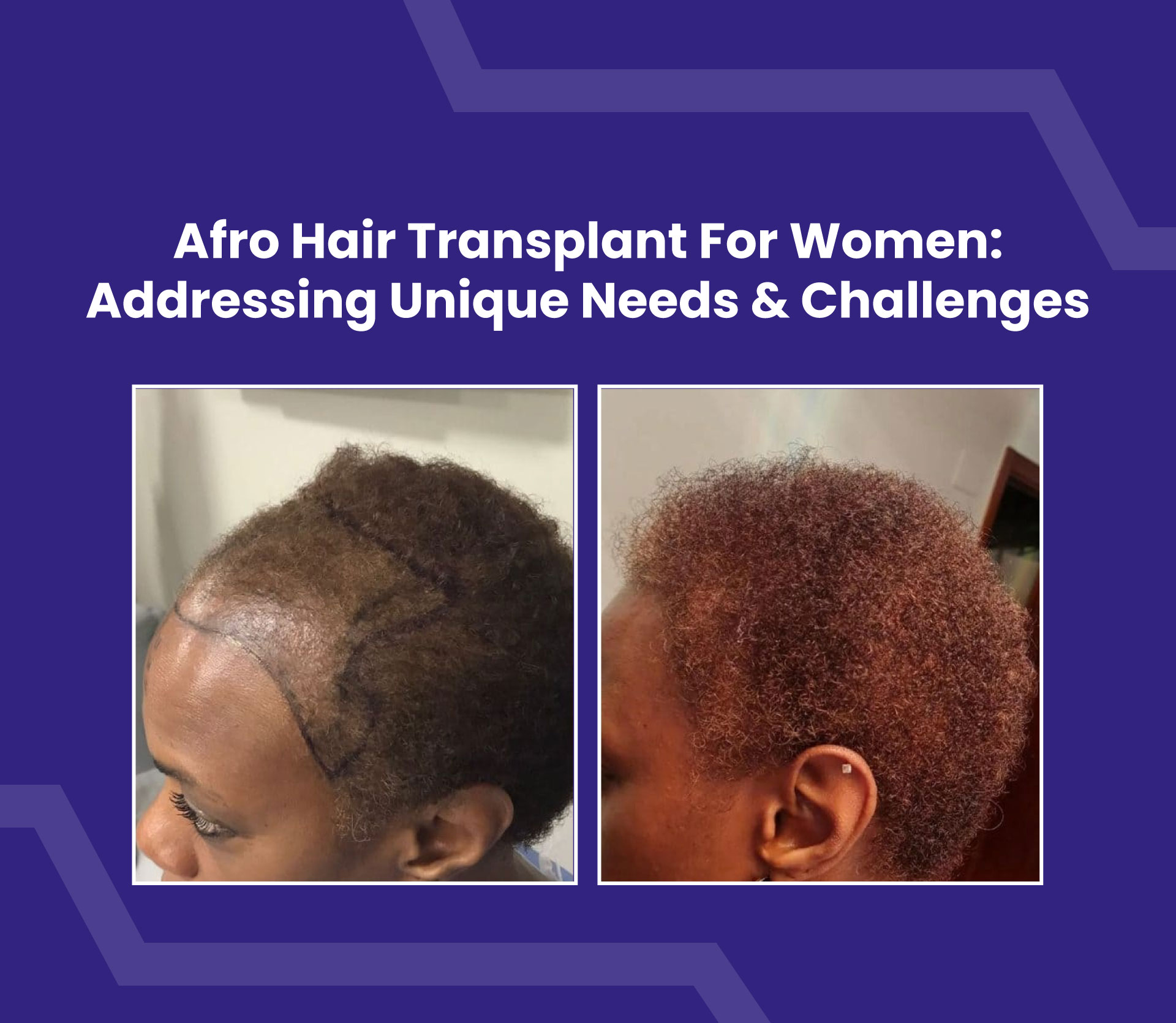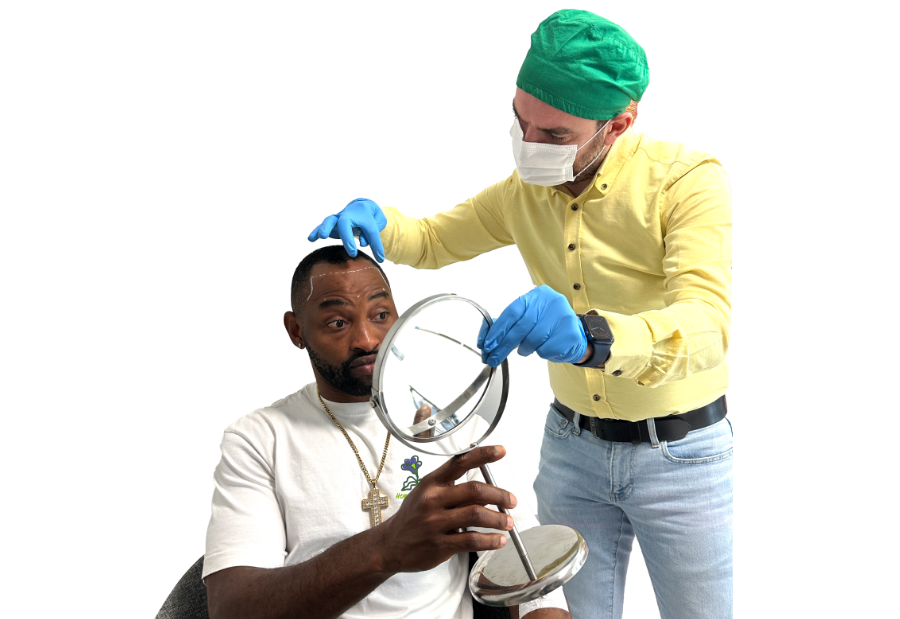Get 25% OFF Hair Transplant Packages This New Year — Book Today!
Afro Hair Transplant for Women: Addressing Unique Needs & Challenges

Introduction: Why Afro Hair Transplant for Women Matters
Loss of hair is difficult for everyone, but for numerous black women, hair loss may come with additional complications. Afro-textured hair does not operate on the same principles as straight/wavy hair; therefore, hair restoration will require different approaches. A standard method that works for someone with fine hair might not give the same results for coily textures. That’s why Afro hair transplants for women are such an important conversation. It’s about restoring confidence with methods that acknowledge curl pattern and cultural identity.
Understanding Afro-Textured Hair: What Makes It Unique
1. Curl Pattern and Density
Afro-textured hair has tight coils. It grows out of the scalp, spiralled above the scalp and spiralled downward into the scalp. Each strand is dense at the root but also fragile along its length. That combination makes it beautiful but tricky during a transplant. Surgeons need to understand how curls behave under the skin, not just on the surface.
2. Challenges for Transplant Techniques
The biggest challenge comes from the curve of the follicle under the scalp. It’s not straight like other hair types. If a surgeon uses standard tools without adjusting for this shape, follicles can break during extraction. That’s why experience with Afro hair is non-negotiable. It takes skill and the right equipment to get it right.
Common Causes of Hair Loss in Black Women
1. Traction Alopecia
This is one of the top reasons for thinning edges and bald patches for Black women. Years of tightly worn braids, ponytails, hair eye extensions, or weaves can cause enough pulling at the hair follicle that they become weak or scarred.
2. Hormonal Imbalances
Other conditions like polycystic ovary syndrome, thyroid issues, or the acute hormonal imbalances caused by childbirth can start hair shedding. Hair loss in women can look like thinning all over the scalp or patches where the hair is just thinner than the surrounding scalp.
3. Central Centrifugal Cicatricial Alopecia (CCCA)
CCCA is a type of scarring hair loss that starts in the crown and spreads outward. It appears to be more common in women of African descent and will require attentive medical treatment before surgery could even be planned.
4. Genetic and Lifestyle Factors
Things like stress, poor eating, and family history could contribute to some types of hair loss. Lifestyle decisions can influence genetic outcomes. Some people may be able to reduce or eliminate some risk by considering an appropriate eating plan and eliminating tension hairstyles.
What makes the Restoration Room’s Afro hair transplant approach unique in the hair restoration market?
At Grace Touch Clinic, the Restoration Room treats Afro-textured hair as its own discipline not a variation of “standard” transplants. Our team designs every step around curl physics, coil density, and scalp biology common in Type III–VI hair. That means harvesting at curl-safe angles to protect the hair’s subdermal curve, planning density by curl-expansion (how coils fill visual space), and building hairlines that respect Afro-centric aesthetics (temporal points, edges, and baby-hair flow). We also follow keloid-aware protocols and textured-hair aftercare so healing stays smooth for sensitive scalps.
In practice, this looks like:
-
Curl-pattern mapping & donor–curl indexing during consults to set realistic graft counts for Afro hair.
-
Micro-punch FUE with curl-safe trajectories to minimize transection and preserve graft integrity.
-
Edge & crown preservation planning so protective styles (braids, wigs, weaves) remain viable post-op.
-
Keloid-aware healing pathways (gentle closure techniques, careful tension control, scar-minimizing routines).
-
Texture-safe aftercare (wash routines, low-tension styling guidance, and regimen alignment with natural/protective styles).
Can Women with Afro Hair Get a Hair Transplant?
Yes, and many do. But it’s not a one-size-fits-all decision. Surgeons look for a few key things:Is the hair loss stable? Is there enough donor hair at the back or sides? Does the patient understand what’s realistic? Meeting these conditions helps ensure good outcomes.
Here is the complete guide you need to know about Afro hair Transplant.
What are some of the key things people look for in Afro hair transplant specialists?
Patients with Afro-textured hair look for surgeons who routinely treat tightly coiled curl patterns and can show before-and-after results for Afro/Type 4 hair. They want proof the team understands follicle curvature (to avoid high transection rates), can plan natural, soft hairlines for women, and will protect donor density especially when traction or central centrifugal cicatricial alopecia is involved. Safety is equally important: careful keloid risk assessment, experience working on darker skin tones (to minimize hyperpigmentation), and clear post-op care that respects protective styles.
Quick checklist you can add to your consultation notes:
Documented experience with Afro hair FUE (curved/ultra-sharp punches, appropriate punch sizes) and low transection rates
Strategy for traction alopecia and female hairline design (temporal points, density planning)
Approach to scarring/keloid risk and pigment-safe techniques; guidance on hyperpigmentation prevention
Transparent graft accounting, pricing, and realistic density goals for women
Tailored aftercare: wash routine, protective styles, heat/chemical avoidance, PRP or medical therapy where indicated
A gallery of Afro-specific results and patient reviews; willingness to do a scalp assessment before committing
Techniques Best Suited for Afro Hair Transplants
1. Follicular Unit Extraction (FUE)
FUE is popular for being less invasive than other options and for allowing patients to not have a long scar. With athletes and afro hair, the surgeon will likely utilise specialised curved punches in FUE to help the surgeon follow the natural curl of the hair follicle associated with their unique pattern. This afro hair implant method reduces the potential for damage during graft extraction and can improve graft survival once the follicle is safely extracted.
2. Direct Hair Implantation (DHI)
The difference across the DHI method is that follicles are pushed or placed directly into the scalp with an implanter pen. For women with afro hair, this method can be particularly beneficial to provide more control of the curl, direction, and density of the curls. That means the final look blends in more naturally with existing hair.
3. Special Equipment & Handling
Tools matter. It is important that curved punches, angled incisions, and delicate treatment of the follicles during graft placement are all used during the hair restoration process. Without these adjustments, transplanted curls can lose their natural shape.
Before your procedure, it’s worth exploring the various afro hair transplant techniques that deliver natural-looking density.
Challenges in Afro Hair Transplant for Women
1. Difficulty in Extracting Curved Follicles
The extraction processes might take longer because the follicles curve underneath (rather than growing straight out of) the skin and may be susceptible to snapping if not carefully prepared.
2. Higher Risk of Scarring and Keloids
Some women with darker skin tones are more prone to keloids. This makes surgical planning even more important.
3. Designing a Natural Hairline for Curly Hair
A straight-line design rarely looks natural on Afro hair. Surgeons often create soft irregular lines in the pattern that curly hair grows.
4. Limited Donor Area in Some Cases
When the donor area weakens, the options are limited and this is the only time to try a mix of surgery and additional features that will work.
Choosing the Right Surgeon: Expertise in Afro Hair is Non-Negotiable
1. Experience with Afro Hair Cases
Some surgeons haven’t heavily consulted on Afro-textured hair. Patients always ask for case studies or before-and-after results from patients.
2. Patient Portfolio with Afro Results
Seeing actual results for another patient builds trust. Portfolios of before-and-after results provide insight about how any surgeon achieves visible density, achieving a curl that looks natural.
3. Cultural Sensitivity and Gender Awareness
For most women, hair represents their identity. A doctor who knows and recognises the journey is understanding, from their technique to the way they communicate.
Recovery, Results & Aftercare Tips
1. Post-Surgery Timeline
Often, transplanted hair will shed within a few weeks. New hair growth starts fighting through, slowly, and then can take about 6–12 months to establish the final results.
2. Aftercare Tips
- Keeping your scalp moisturized
- Avoiding constricting hairstyles for at least 6 months
- Not using sulphate shampoos to interact with scalp dryness.
3. Protecting Curl Pattern
Hydration and damage-free styling keep transplanted curls in good condition. Over-processing or heat styling too soon may allow the new growth to be weak.
Real Patient Stories & Before-After Images
Hearing from other women who have gone through it can help make the process less daunting. Many women report the emotional lift they feel from seeing their hairline restored. before-and-after images can also go a long way in setting realistic expectations and taking the focus off immediate change and instead focusing on your progress over time.
Here are the actual before and after results
Cost of Afro Hair Transplant for Women
The price varies widely:
- USA: $5,000 – $15,000
- UK: £3,500 – £10,000
- India: ₹80,000 – ₹250,000
The final costs ultimately depend on individual graft numbers. The technique you choose and the reputation of the clinic will also play a part in the final costs. Many women also consider other hair transplant options, such as a hair transplant in Turkey, where many clinics are focused on low prices and experienced surgeons.
If you’re considering a procedure designed for unique hair textures, check out our detailed guide on African American hair transplant for tailored solutions.
Alternatives to Hair Transplants for Black Women
1. PRP (Platelet-Rich Plasma) Therapy
Uses growth factors from the patient’s own blood to stimulate hair follicles.
2. Scalp Micropigmentation (SMP)
It creates the appearance of fuller hair with tiny pigment dots on the scalp.
3. Natural Oils & Supplements
Folk remedies such as castor oil, rosemary oil, and biotin supplements are not uncommon as part of supportive care for the loss of any type of hair.
4. Protective Styling & Quality Wigs
In some cases, non-surgical options could be a good, temporary comfort until more longer-term options can be explored.
FAQs About Afro Hair Transplants for Women
Q1. Will my natural curl pattern remain after transplant?
Yes, assuming the follicles are both manipulated and handled with skill by the surgeon.
Q2. Are there risks of hair not growing?
While rare, having a poor technique or not following correct aftercare practices could produce mediocre results.
Q3. Can I braid or relax my hair post-transplant?
Wait at least six months before trying. The scalp needs time to heal.
Q4. Is the procedure painful?
Typically yes, because we use local anaesthetic, most patients only experience minor discomfort postoperatively.
Final Thoughts: Empowering Black Women Through Hair Restoration
With afro hair transplants in Turkey specifically, it is more than just filling in gaps. It’s about returning comfort and confidence in a way that respects curl pattern, cultural identity, needs, and the individuals’ hair story. When conducted by a qualified surgeon, with realistic expectations and the surgeon’s instruction of post-operative care, the results of hair restoration surgery can be life-changing. For many women when asked about the question of “is hair transplant worth it?” the answer is a decided yes. Choosing the best hair transplant in Turkey, Istanbul, means finding a clinic that combines skilled surgeons, advanced techniques, and trusted patient results for natural-looking outcomes.

